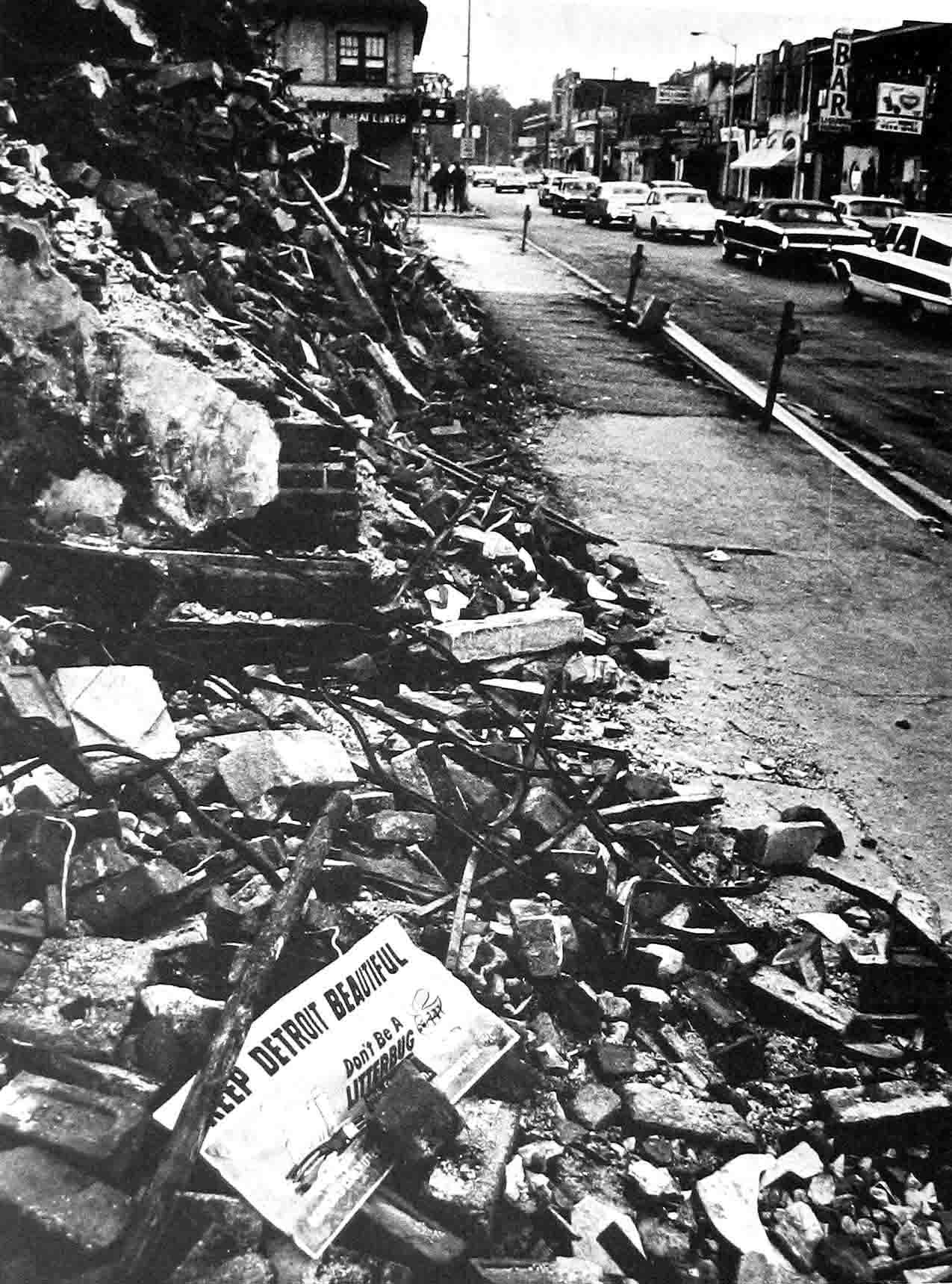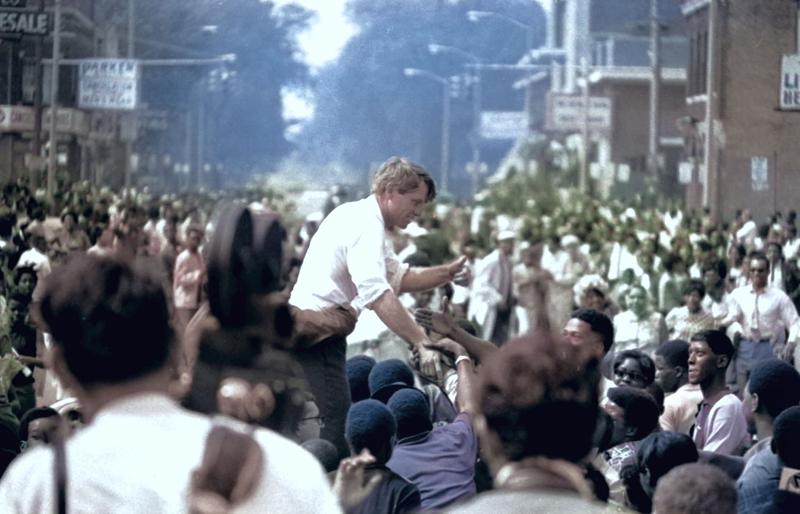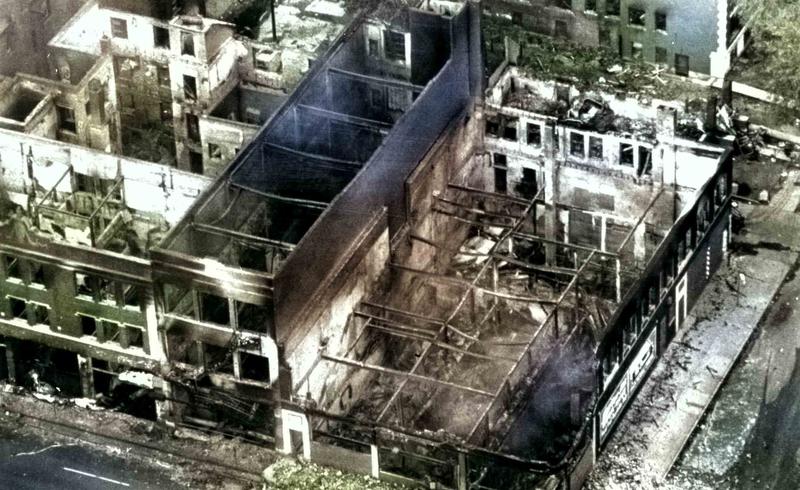12th Street - Requiem for a City
The Kaleidoscope of Catastrophe
During the depression years of the 30s, 12th Street was a Jewish ghetto. It was a Jewish ghetto which was poor. If a man could get one day’s work a week he was a rich, for excellent flats rented for $15 to $20 a month and food was cheap. Getting that one day’s work was a problem and during these lean years the numbers racket flourished, with many Jewish housewives dreaming of hitting it big as the only salvation of their money problems.
The Jewish merchants who were scrambling for a living in the little grocery stores, butcher shops, and delicatessens had to extend credit to stay alive. They kept their accounts on the backs of envelopes or on pieces of wrapping paper. Many an argument would develop as to who owed what. But it was all in the family. Both the business and the customers were Jewish.
A City within a City
Twelfth Street was the turf of the infamous Purple Gang, known for the Collingwood Street massacre of 1931, and simultaneously, the turf of the Jewish intellectual. President Roosevelt was the big hero, a leader who cared for the little man. You could start a conversation on any subject and on any street corner at the drop of a hat, or play pool at the corner pool hall dominated by the Purple Gang. It was like a little village where everyone knew each other and had common antecedents.
Somehow in all this poverty, there was never poverty of the mind. Although there was job discrimination against the Jews in all professions, still Jews went in disproportionate numbers to college and prepared themselves for life. During the Depression, trained engineers worked as parking attendants. Only civil service and teaching jobs seemed to be open. Jews flocked into these occupations.
World War II changed everything. Suddenly doors which were once locked now flung open. By the time blacks were ready to move into 12th Street, the second generation of Jews was ready to make the trek to suburbia and beyond. When blacks arrived on 12th Street after WW II, it was as if history was repeating itself, but not entirely. There were vast differences.
The first waves of blacks were not the poor, but rather the middle class with some money in their pockets and attempting to move out of the burgeoning ghetto along Hastings Street, which had erupted into the bloody riot of 1943. Twelfth Street became the new Hastings Street for the black who could escape Paradise Valley.
But there came a series of events which disrupted 12th Street. When Hastings Street was torn down during urban renewal to make way for a new expressway and middle class high rises, 12th Street began to bleed. Shadowy underworld figures, the prostitutes, the career poor and the cheap bars moved in from the now defunct Paradise Valley. When skid row along Michigan Avenue was razed, the pawn shops and second hand stores flocked to 12th Street with magnetic strength. Once spacious apartments were sub-divided, then divided again to make room (and money) for the avalanche of poor.
An argument between a customer and a shopkeeper over how the credit “books” were kept or over prices was no longer a affair between two members of the same ethnic group. It was a racial incident. For the shops were largely owned by “left over” or newly arrived white and the customers were now black.
In prostitution, the reverse was largely true. The customers were white and the women merchandising themselves were black. In police raids, the “Johns” were not arrested, only the black prostitutes. Morality was a one-way street.
Twelfth Street became the Boulevard of broken dreams that eventually exploded. For most of the blacks it did not become a temporary stop on the way up as it had been for the Jews. For this, in part, we can blame racism which has always been on a higher scale for blacks.
Detroit had gone from being the "Model City" of race relations and opportunity to the poster child for anarchy, physically resembling a bombed out Stalingrad of WWII.
It began early on a Sunday morning in an orgy of flames and violence, a lust for destruction and revenge for past wrongs. The looting, which had been incidental to the riot, became the chief reason for prolonging it. It was too sweet, too simple and too stupid not to join in.
A week before the riot, 12th Street was the community sin strip - an area of 22 bars and 15 liquor stores, pawn shops and barbeque joints. A place where pimps showed off their new Cadillac and prostitutes went off with white “Johns.” On the best of days, under the best of conditions, 12th Street and its arteries, from the Boulevard to Clairmount and from Dexter to Woodrow Wilson - 169 blocks - is a rough area saturated with the seeds of unrest.
During the daylight hours, 12th Street is the kind of place people dream of getting out of. At night, too many of the people that did get out mysteriously come back.
Some 145,000 people, mostly poor, are jammed into its 6 1/2 square miles. On hot, summer nights 12th Street had the flurry of an ant colony that operated on the frontier of the law. Any outsider who mistakenly made a wrong turn onto 12th Street would not have made that mistake twice. They would have seen young toughs in tight pants and long hair - brave with whiskey. Prostitutes solicited without fear. Holdups were so common they went unreported daily. Numbers slips passed hands, small children stole, pawn shops did a thriving business, the street was clogged with cars and the litter left behind. But awful as the sin strip could be, it danced with life and diversity. Twelfth Street housed the city’s poorest residents and, not coincidentally, the highest crime rate. It was the city’s red light district – the place to go for fast money, fast women, fast drugs and fast times.
A week after the riot, 12th Street was a 17 block ruin of jagged, fire scarred walls, ceilings collapsed into basements, shattered water pipes continued to flood any and all remaining cavities. Giant, twisted girders which once held up the thriving business district now look like melted licorice sticks that can’t support their own weight.
Remnants of once colorful store windows now sat decomposing in flooded basements of the blackened, riot scarred street which once bustled with life. Twelfth Street was now only a heap of ruins.
“It was mostly a rebellion against circumstances”, said one Cavanagh assistant, “of a people who have no stake in society, people of both races. You put up with the status quo as long as it works for you. If you are going nowhere and there is no end in sight, then the hostility grows.”
Many of the old school Detroiters tried to stop the riot, to no avail. Knowing all too well what the ramifications would be, now all they can do is wonder at the folly of it all.
Despite the progress Detroit made under Cavanagh, thousands of residents still lived in a nightmare world of slums where rats abound and archaic wood burning stoves ward off old man winter in Dickens-type squalor and await the slow progress of bureaucracy.
Black leaders said the answer may lie right in the middle of the good race relations the city thought it enjoyed. Good, yes, but for whom? It was generally considered that Detroit had had its blood bath early - in 1943 - and had learned its lessons so they were beyond rioting.
One 25 year old black man voiced his frustrated opinion, “Blacks have been angels. If people have been oppressed and kicked around like my people and haven’t rebelled, they deserved medals.”
Investigative findings after the riot found that the average rioter was someone who is at the bottom of the socio-economic barrel. The bulk of the rioters were between the ages of 15 and 24. Only 4 percent were over 50.
There was also a strong relationship between rioting and the length of unemployment. Those who had been jobless for more than a year were three times more likely to riot as those who were unemployed for only a month.
One distinctive attitude which began to emerge was that many blacks who rioted admitted that they not only felt alienated from whites but also from other blacks.
Bobby Kennedy, a civil rights champion himself, once said:
Today, 12th Street stands as only a ghostly apparition can, suspended somewhere between life and death, staggering onward like a great marathon runner on his last legs. Economy Printing, the flash point of the riot, was razed back in the 70's because of its increasing iconic powers. However, if one stands at 9125 12th Street and stairs southward down the rod straight boulevard, you can still imagine the bustle of the old days when gefilte fish and BBQ joints created a unique existence rivaling an old world bazaar and ended with the passing of Old Detroit as history knew it.
Post Mortem
The razing of 12th Street - For years following the riot, 12th Street resembled a mile long jagged scar, a constant reminder of the five day war that ravaged the legendary thoroughfare. Twelfth Street, Linwood and Grand River became grim and empty corridors, a checkerboard of weed choked empty lots. Concrete slabs marked the graves of looted and burned out stores that once represented the livelihood of hard-working immigrants.
Fire gutted buildings were razed and salvaged buildings were bought out by the city so the street could be turned into a boulevard. Other area businesses began to take on a fortress like appearance as their showcase front windows were bricked up in preparation for the next disturbance. Proprietors left their stores at night with guns drawn, got in their cars and headed for the suburbs.
Perhaps the irony of ironies is that 12th Street had been slated for urban renewal years before the riot, so this 'sin strip' would have been razed, riot or not. It is doubtful but possible that had 12th Street been razed years earlier that a riot might have been averted all together.
On a warm spring day in 1968, U.S. Senator Bobby Kennedy, himself a declared candidate for the presidency, campaigns in the heart of 12th Street, only yards from where the riot ignited a year before. If there was any white man alive that black society trusted, it was Bobby Kennedy. It was he who prodded his brother John to initiate civil rights legislation.
This photo was taken only a month after the assassination of Martin Luther King, an event that caused more rioting in this very area and across the country. This would be Kennedy's last trip to Michigan, as only three weeks later he, too, would be dead of an assassins bullet.



